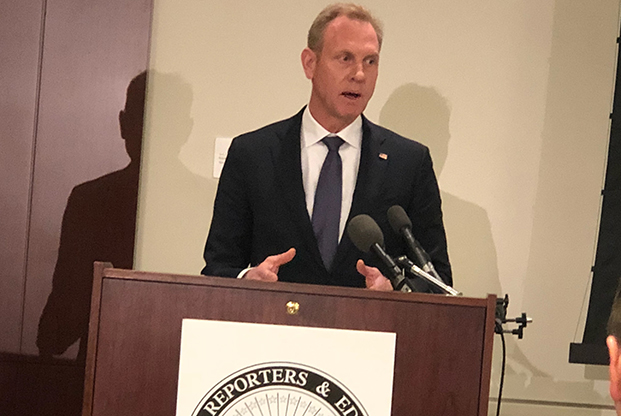
Deputy Defense Secretary Patrick Shanahan speaks Friday at the 2018 Military Reporters & Editors conference in Arlington, Va. Staff photo by Amy McCullough.
The Defense Department has not yet worked out what the new Space Force will actually look like or how much it will cost to create, but those answers are coming soon, Deputy Defense Secretary Patrick Shanahan said on Friday.
Shanahan acknowledged the Air Force’s estimate that it will cost $13 billion to establish the new service over the course of the five-year Future Years Defense Program, but he urged reporters to “put that number aside” and wait until details of the Fiscal 2020 budget are released.
“Next week we’ll start to see those initial numbers,” he said during a Military, Reporters, and Editors Conference in Arlington, Va. “When we talk about final approach on the [Fiscal 2020] budget, right now is when we have to lay in those numbers. The way I think about it is, ‘How fast do we want to go? How many pieces of the organization do we want to move simultaneously?’ Our biggest thrust is Space Command and these capabilities.”
Shanahan said the department would mostly be shifting existing resources to the Space Force rather than going to Congress to ask for more funds, though he pushed back on the idea that the Air Force, which currently manages roughly 90 percent of the National Security Space portfolio, would take a hit that might impact readiness in other areas.
“The money is going to all be the same, so the total dollars aren’t going to change, but we’re going to do it three different ways. I don’t think there’s going to be hits,” said Shanahan.
He said one of the goals of the new service is to bring all space capabilities under one umbrella. The new Space Development Agency, which the administration has said would be tasked with rapidly developing and fielding new technologies, will be key to this. Shanahan noted that the “Missile Defense Agency, the Army with its Army Futures Command, and the Air Force with things like its JSTARS” will all “use space.” What he’s been focused on is figuring out where the commonalities lie in all those areas.
“The biggest challenge is not the technology, it’s how do you get the Department of Defense aligned? The challenge won’t be the technology, the challenge will be how do we adapt commonality? How do we deploy standards, … so if the Army is first in order to develop a component of our space architecture, how do we get everybody to hold hands and say the Air Force is going to adopt the same thing? Adoption doesn’t mean, ‘well it will be like that.’ It’s 100 percent. The notion of the Space Development Agency is that that’s where all the players go, so you are locked in, so you can’t have agreements … and immediately everybody diverges.”
The Space Development Agency, he said, also will ensure territorial issues do not become a problem as the services merge their capabilities and resources.
When asked what the new service will look like, how the personnel transition will play out, and whether there will be a Space Guard, for example, Shanahan said, “I don’t know.”
The department is still working out the answers to those questions, but it needs to come up with a plan soon.
“By December I need to have a legislative proposal, and the thing about the legislative proposal is if it’s really vague they are going to send it back, so we have to have enough detail so that our engagements with Congress are credible,” said Shanahan. “I haven’t found people who say getting after the threat or being defensible in space isn’t important. That’s universal. It’s the how [that’s done, that’s debatable]. And if we serve up a big bill, it’s not OK, so that’s the piece we’re really working on.”